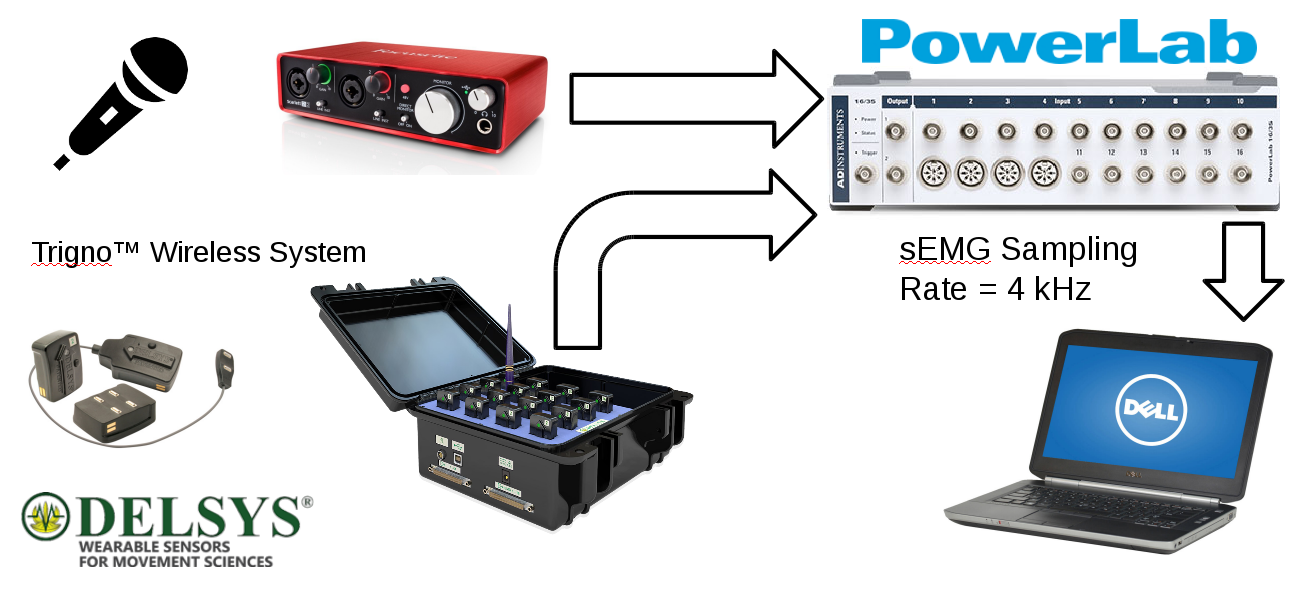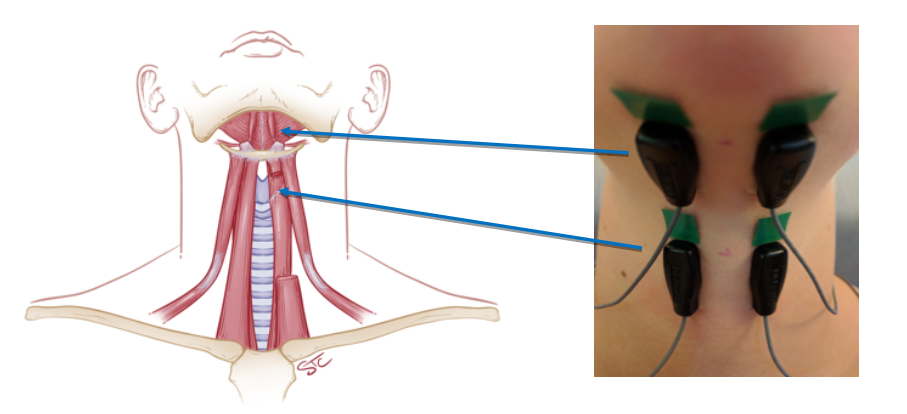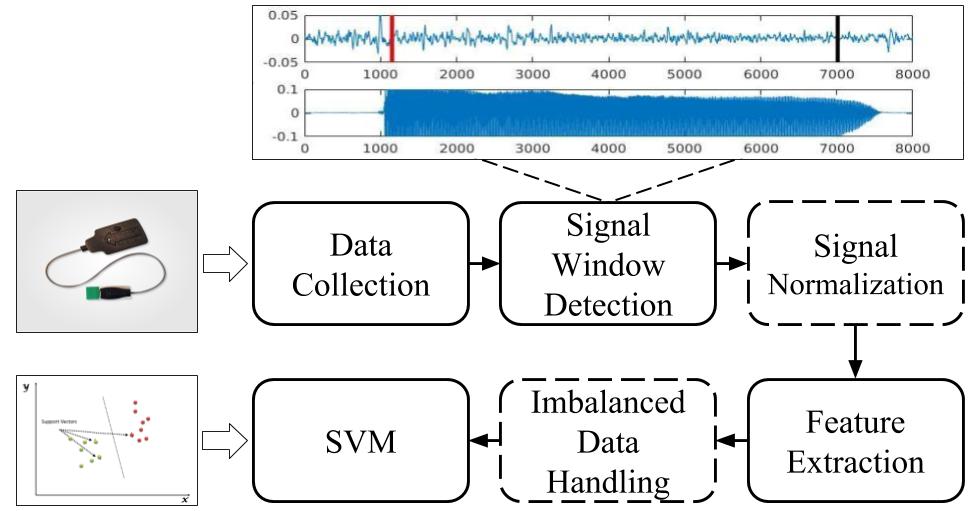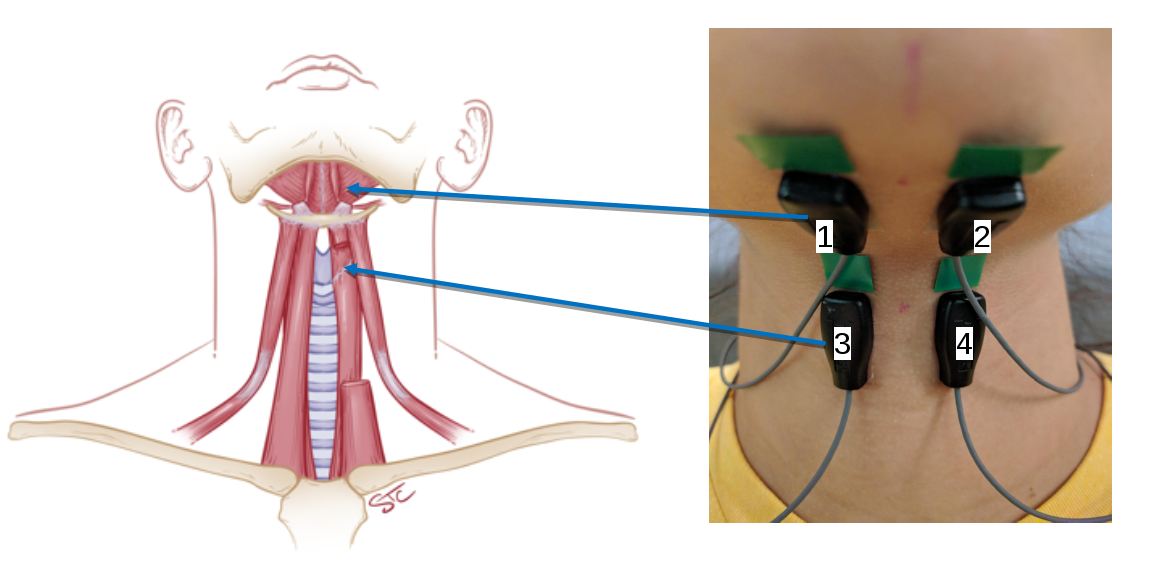





The goal of the project is to determine the validity and reliability of a novel sEMG pattern recognition system to detect vocal fatigue.
National Institute on Deafness and Other Communication Disorders (NIDCD) of the National Institutes of Health under Award Number R15DC015335

Placement of the electrodes for data collection
This dataset includes sEMG signals from submental and infrahyoid muscle groups during a sequence of voice, speech, and non-speech productions. Acoustic signals were recorded simultaneously. Signals were collected from 61 female participants (teachers and non-teachers) who were in good general health with varying degrees of vocal fatigue as measured by the Vocal Fatigue Index (Nanjundeswaran, Jacobson, Gartner-Schmidt, & Verdolini Abbott, 2015). Participants showed normal mid-membranous vocal fold closure during comfortable pitch and loudness based on laryngeal videostroboscopy. The study was approved by the Institutional Review Board of the University of Missouri. All participants gave informed consent and consented to be included in the database.
The dataset includes information on and can be filtered by:
The equipment was installed in a sound-attenuating booth (IAC Acoustics, North Aurora, IL) and included: a base station and four wireless TrignoTM Mini sEMG sensors with a built-in bandwidth of 20 Hz to 450 Hz (Delsys, Natick, MA); a head-worn microphone (AKG, Model C520, Vienna, Austria); an audio interface (Scarlett 2i2, Focusrite, High Wycombe, UK); and a data acquision device (PowerLab 16/35, ADInstruments, Dunedin, New Zealand), which performed synchronized sampling of audio and sEMG signals using LabChart for Windows. The sampling rate was set to 4 kHz for the sEMG signal and 20 kHz for audio, both with 16-bit quantization.
| Task | Description | Reps | Time |
|---|---|---|---|
| baseline | Neutral with no movements for collecting pure noise | 1 | 2 secs |
| syllable1 | "afa afa afa ifi ifi ifi ufu ufu ufu" | 1 | 6 secs |
| /a/ normal | /a/ as in honest | 55 | 2 secs |
| /u/ normal | /u/ as in you | 55 | 2 secs |
| /i/ normal | /i/ as in feel | 55 | 2 secs |
| sentence1 | "The dew shimmered over my shiny blue shell again" | 55 | 4 secs |
| sentence2 | "Only we feel you do fail in new fallen dew" | 55 | 4 secs |
| syllable2 | "afa afa afa ifi ifi ifi ufu ufu ufu" | 1 | 6 secs |
| /a/ pressed | /a/ with breath hold | 55 | 2 secs |
| throat clear | Single throat clear | 55 | 1.5 secs |
| /u/ pressed | /u/ with breath hold | 55 | 2 secs |
| cough | Single cough | 55 | 1.5 secs |
| /i/ pressed | /i/ with breath hold | 55 | 2 secs |
| syllable3 | "afa afa afa ifi ifi ifi ufu ufu ufu" | 1 | 6 secs |
| 100% MVC | Maximum voluntary contraction | 3 | 8 secs |
| 50% MVC | Submaximal voluntary contraction | 3 | 15 secs |
1 Y. Gao, M. Dietrich, M. Pfeiffer and G. N. DeSouza, "Classification of sEMG Signals for the Detection of Vocal Fatigue based on VFI Scores," 2018 40th Annual International Conference of the IEEE Engineering in Medicine and Biology Society (EMBC), Honolulu, HI, 2018, pp. 5014-5017
We appreciate your interest in our research. By downloading the sEMGv1 dataset, you and/or your research group are agreeing to cite our sEMG dataset and the associated paper(s) in any form of publication produced by you/your group using the same dataset.
Y. Gao, G. N. DeSouza, and M. Dietrich. Laryngeal sEMG Dataset, v.1, Columbia, MO: University of Missouri, Department of Electrical Engineering and Computer Science and Department of Speech, Language and Hearing Sciences, 2020. http://vigir.missouri.edu/Research/sEMG_dataset.htm
Y. Gao, M. Dietrich, M. Pfeiffer and G. N. DeSouza, "Classification of sEMG Signals for the Detection of Vocal Fatigue based on VFI Scores," 2018 40th Annual International Conference of the IEEE Engineering in Medicine and Biology Society (EMBC), Honolulu, HI, 2018, pp. 5014-5017. doi: 10.1109/EMBC.2018.8513224
A separate request must be made from any members outside your research group or institution.
We value feedback, which you can leave here.